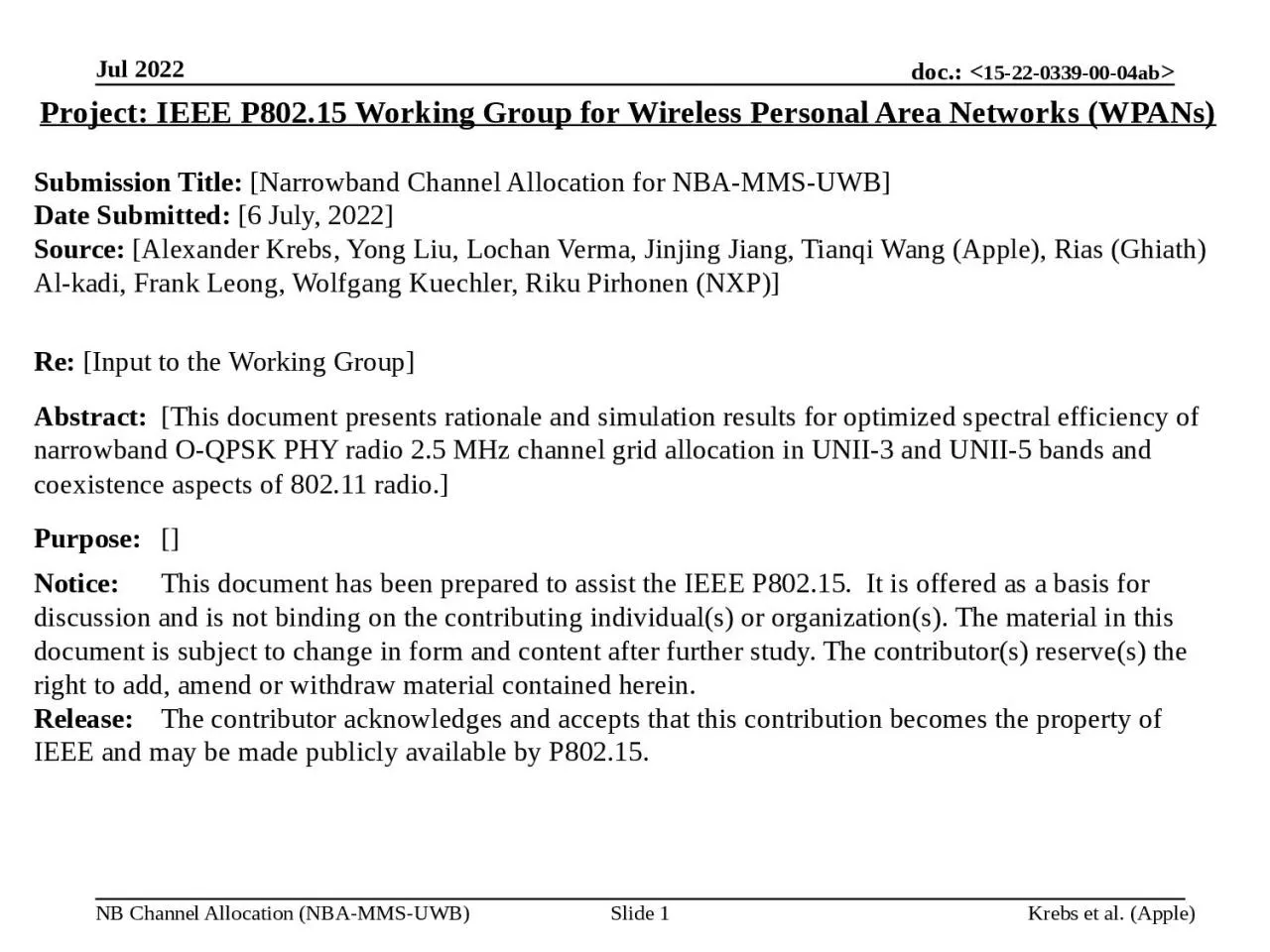

Slide 1 Project IEEE P80215 Working Group for Wireless Personal Area Networks WPANs Submission Title Narrowband Channel Allocation for NBAMMSUWB Date Submitted 6 July 2022 Source ID: 1001676
Download Presentation The PPT/PDF document "Jul 2022 Krebs et al. (Apple)" is the property of its rightful owner. Permission is granted to download and print the materials on this web site for personal, non-commercial use only, and to display it on your personal computer provided you do not modify the materials and that you retain all copyright notices contained in the materials. By downloading content from our website, you accept the terms of this agreement.
1. Jul 2022Krebs et al. (Apple)Slide 1Project: IEEE P802.15 Working Group for Wireless Personal Area Networks (WPANs)Submission Title: [Narrowband Channel Allocation for NBA-MMS-UWB] Date Submitted: [6 July, 2022] Source: [Alexander Krebs, Yong Liu, Lochan Verma, Jinjing Jiang, Tianqi Wang (Apple), Rias (Ghiath) Al-kadi, Frank Leong, Wolfgang Kuechler, Riku Pirhonen (NXP)]Re: [Input to the Working Group]Abstract: [This document presents rationale and simulation results for optimized spectral efficiency of narrowband O-QPSK PHY radio 2.5 MHz channel grid allocation in UNII-3 and UNII-5 bands and coexistence aspects of 802.11 radio.]Purpose: []Notice: This document has been prepared to assist the IEEE P802.15. It is offered as a basis for discussion and is not binding on the contributing individual(s) or organization(s). The material in this document is subject to change in form and content after further study. The contributor(s) reserve(s) the right to add, amend or withdraw material contained herein.Release: The contributor acknowledges and accepts that this contribution becomes the property of IEEE and may be made publicly available by P802.15.
2. PAR ObjectiveProposed Solution (how addressed)Safeguards so that the high throughput data use cases will not cause significant disruption to low duty-cycle ranging use casesInterference mitigation techniques to support higher density and higher traffic use casesOther coexistence improvementBackward compatibility with enhanced ranging capable devices (ERDEVs)Improved link budget and/or reduced air-timeO-QPSK occupied bandwidth based channel spacing optimization for spectral efficiencyAdditional channels and operating frequenciesAllocation band map of NB channels in UNII-3/5Improvements to accuracy / precision / reliability and interoperability for high-integrity rangingReduced complexity and power consumptionHybrid operation with narrowband signaling to assist UWBThis describes the NB partEnhanced native discovery and connection setup mechanismsSensing capabilities to support presence detection and environment mappingLow-power low-latency streaming Higher data-rate streaming allowing at least 50 Mbit/s of throughputSupport for peer-to-peer, peer-to-multi-peer, and station-to-infrastructure protocolsInfrastructure synchronization mechanismsJul 2022Krebs et al. (Apple)Slide 2
3. NB O-QPSK SpectrumLegacy 802.15.4 O-QPSK [1] channel allocation is not optimizedO-QPSK 99% occupied bandwidth (OBW) [2] less than 2.4 MHzBelow graphs compare 802.15.4 O-QPSK vs BLE 2M GMSK PHY (dashed line)Notably, BLE uses 2 MHz spacing, whereas legacy O-QPSK uses 5 MHzJul 2022Krebs et al. (Apple)Slide 3OBW < 2.4 MHzOBW > 2 MHz
4. NB Channels2.5 MHz channel spacing results in250 channels in aggregated UNII-3+5 (~229 permitted in most regions world wide)Center frequencies we investigate currently (aligned vs. unaligned) AlignedUnaligned Jul 2022Krebs et al. (Apple)Slide 4
5. NB Performance 1/2Simulation parametersK Tx-Rx pairs randomly placed in 100m x 100m square, isotropic ant., P_out=10dBmRandomly selected channels within 125 MHz of total BW, 10 byte PSDU, B2B packetsACI via sum of FSPLs at 5.8GHz, PER via inverse SINR waterfall curves from [3]Jul 2022Krebs et al. (Apple)Slide 5+94%Data Rate = 250kbps: Preamble length = 128us, SFD length = 32us, PHR length = 32us, Payload length = 320us, Total packet duration: 512us
6. NB Performance 2/2Additional O-QPSK modes proposed in [4]Jul 2022Krebs et al. (Apple)Slide 6250 kbps1000 kbps500 kbps5 MHz 2.5 MHzData Rate = 500kbpsNote both PHR and the payload go through the rate-1/2 convolutional code with generator polynomials (133, 171) as specified in Clause 21.3.6 of IEEE 802.15.4-2020 or in Clause 15.3.3 of IEEE 802.15.4z-2020Preamble length = 64usSFD length = 32usPHR length = 28usPayload length = 172usPHR carries (8+6)x2 = 28 coded bitsPayload carrier (80+6)x2 = 172 coded bitsTotal packet duration: 296usData Rate = 1000kbpsPreamble length = 64usSFD length = 32usPHR length = 8usPayload length = 80usTotal packet duration: 184us
7. SummaryGiven the analyzed spectral properties of 802.15.4 O-QPSK modulation, we propose allocation of a total of 250 NB channels in UNII-3 and UNII-5 bands with channel spacing of 2.5 MHz, in order to increase spectral efficiency over the 5 MHz channel spacing used in legacy 802.15.4 at 2.4 GHz.Simulations results show potential for increase in maximum network throughput for the legacy 250kpbs O-QPSK PHY, as well as the newly proposed 500 kbps CC r=1/2 K=7, and uncoded 1 Mbps modes, over both low and high density deployment use cases.The proposed channel spacing targets current and prospected regulatory requirements in most regions world wide, under particular consideration of the occupied bandwidth criteria from ETSI and guard band requirements from FCC.Jul 2022Krebs et al. (Apple)Slide 7
8. References[1] “IEEE 802.15.4-2020 Standard for Low-Rate Wireless Networks”, LAN/MAN Standards Working Group.[2] ETSI EN 302 867 Draft 1, April 2022.[3] S. Lanzisera and K. S. J. Pister, "Theoretical and Practical Limits to Sensitivity in IEEE 802.15.4 Receivers” 14th IEEE International Conference on Electronics, Circuits and Systems, 2007, pp. 1344-1347.[4] X. Luo (Apple Inc), F. Leong (NXP), M. Lee (Samsung Electronics), et. al., “NBA-UWB Technical Framework Proposal”, 15-22-0262-01-004ab.Jul 2022Krebs et al. (Apple)Slide 8